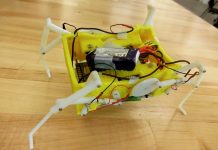Researchers at Brown University have developed new 3D-printed hydrogel components which can be used to create custom robots using LEGO-like building blocks. The technology has a variety of exciting applications in robotics and biomedicine, rendering the process of robot assembly both quicker and more accessible.
The hydrogel components are patterned by a 3D printer and respond differently to different chemicals. The hydrogel building blocks can thus be assembled in custom devices which can then be used for drug screening, cell cultures and similar applications.
A Compound Greater Than The Sum Of Its Parts
The dual-polymer composition enables the newly formed component to be both stronger and more responsive than individual polymers.
Thoomas Valentin, the paper’s lead author, explains: “Essentially, the one polymer provides structural integrity, while the other enables these dynamic behaviors like bending or self-adhesion. So putting the two together makes a material that’s greater than the sum of its parts.”
The first type of polymer – called PEGDA – holds the material together, while the second – called PAA – enables the bond to become responsive to its environments. The PAA will become more rigid and contract in an ion-rich environment, and soften and swell as the ions are removed.
By leveraging this combination, the researchers were able to create a soft gripper which can shrink and strengthen as desired, being able to lift objects weighing approximately one gram.
Microfluidics Applications
According to the researchers, an immediate application of these dual-polymer hydrogel compounds is in microfluidics. While hydrogels have currently been difficult to pattern with the complex channels required in microfluidics, the implementation of the 3D printing process enables researchers to incorporate complex architectures into each block. Additionally, the LEGO-like combination possibilities allows for accessible assembly customization.
“The modular LEGO blocks are interesting in that we could create a prefabricated toolbox for microfluidic devices,” Valentin says. “You keep a variety of preset parts with different microfluidic architectures on hand, and then you just grab the ones you need to make your custom microfluidic circuit. Then you heal them together and it’s ready to go.”
The Brown University research team say that they will continue to explore different ways to improve the durability and functionality of the polymers, in an effort to open up new applications for the materials.
More info can be found at https://www.sciencedaily.com/releases/2019/03/190321141907.htm.






























